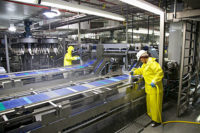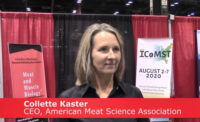Process Q&A
Erlan Rice, director of systems engineering, BPI
Computer technology is a cornerstone of the Beef Products Inc. processing satellite organization, including its own four sites and about 50 sites across the United States owned by other processors.
Systems engineering is the umbrella department, under the leadership of Erlan Rice, director of systems engineering, and his resident techies, totaling 120 people.
Q: Explain your department.
Rice: We service pretty much everything in the company that has electricity running through it. The department is staffed by electrical engineers that work with power delivery and power distribution systems. The controls department designs the wires and conduits that control devices in addition to sensors that read pressure, temperature level, speed, etc. All the wires that go back and forth between the devices on the factory floor and the computer-control systems are planned by systems engineers. Basically, [we] are responsible for providing all the inputs necessary for controlling the operation.
Q: How does the operations center interface with production sites?
Rice: All information flows into the operations center. Currently there are over 80,000 data points flowing into our operations center, all of which are monitored around the clock every day of the year. Operators have written action plans with guidance on responding to operational variances. They have several tools to help them respond, including color graphic displays, video resources, radio systems and conventional telephones.
Q: What is the major benefit of an operations center?
Rice: Traditionally managers find out about problems in the plant the next day when they start asking questions. That means going backward to get to the bottom of variances. Our approach is different because the operations center communicates any variance immediately. People responsible for making the facilities run a certain way can then respond immediately. This applies to any of our remote facilities that use our grinding systems or block grinders and also use our monitoring service.
Q: How about an example?
Rice: Yesterday a California customer called. The customer wanted to change the texture of some of their meat product to help with their patty forming. The company had an idea about a desired change to the way the grinding system was operating. We discussed it and decided together to test the change. We made a phone call to the operations center where the parameters changed within a few minutes. The customer called back within 40 minutes to report the change was implemented and requested a lock on the desired setting. The fact that we can make a change like that is also a testament to the piece of equipment we designed that enables us to change the texture of product to meet the customer’s need just by punching a few buttons. We didn’t have to re-engineer an auger or get new mechanical pieces.
Q: How do you handle the streaming input of variances?
Rice: We see the operations center as a critical function. We have designed backup systems and have multiple network paths for connections to the center. Our data integrity is extremely deep. Obviously we have developed the process over a number of years and refine it as we go. For one thing, we have written our own custom software in which we monitor all the points and also record them. That enables us to look back in review. Data is streaming in and being recorded continuously. Only if it goes out of variance do you necessarily need to look at it. Our custom software is designed so the operator can click on the alarm and automatically pull from a data base the required response to a situation. We call it the action plan. They don’t have to look anything up or memorize what the situation calls for.
Q: Who are the field equipment customers?
Rice: They are other beef grinding operations where we have [Freezing Machines Inc.] grinding installations and frozen block grinding systems that may or may not be monitored through our operations center. The ones we monitor can operate independently, so the umbilical cord can be cut at any time.
Q: BPI equipment is subject to continuous improvement, why is that?
Rice: We have a constant improvement philosophy, which might seem confusing concerning the complexity of our equipment. When we make improvements to our machines, sometimes I’m asked if it is because there is something wrong. Otherwise why the need to make changes? My answer is that the first cars had wooden wheels, which was great at the time. But something better came up, which did not mean wooden wheels were junk but the best available at the time.
Q: What is the ultimate value of round-the-clock monitoring?
Rice: You don’t know until you start looking at things. We are frequently asked why we monitor so completely. For instance, is it important to know the motor ramps on an obscure pump? We have discovered, time and again, elements that were affecting our operation that we were not aware of. You don’t know until you look at it. When you pull all that data into a computer and then ask for correlations, it is easy to find them. For example, a drive system may trip out. We look for load inducement, which is typical. But incoming power lines may cause the variance, so the distribution system was the culprit. The load was constant but the power feeding it was not. You save so much time, not having to chase your tail, by having the right data available.
Q: How are you preparing for the future?
Rice: We are looking down the road concerning our own needs and our customers’. We are making provisions in the event of a natural disaster with even more sophisticated disaster recovery and handling procedures. It is the action plan for that even-tuality.


Report Abusive Comment